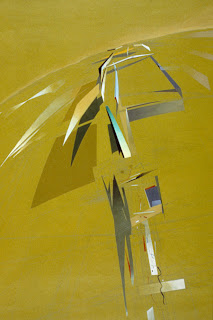Architecture is a constant paradox. It has to be
simultaneously concrete and abstract, theoretical and practical, conceptual and
physical. To me, Zaha Hadid’s Vitra Campus fire station (and maybe her entire
career) is an examination of this constant paradoxical nature of architecture.
I think the fire station also is at the crossroads of what classifies as
architecture and what classifies as art. Zaha Hadid absolutely refutes the
notion of form following function and chooses instead to base her form on the
statement or artistic expression that she wanted to present through the
architecture.
The
fire station is essentially a manifesto that is articulated through the
composition of forms that are derived from highly conceptual and theoretical
ideas. This project is a bold manifestation of Zaha Hadid’s personal takes on
the nature of architecture and how space should be conceived as well as
realized. To me, the project stands out because it almost occupies a space that
is somewhere between physical and conceptual. This was an intentional effect of
the building, shown by the acute attention to keeping the pureness of the
concrete plane unadorned by roof edges or cladding. The glazing even lacks
framing, yet another detail that heightens the impression of the building as
abstract idea that people can somehow move through than an actual concrete
artifact. Even though I do not necessarily find every aspect of the building to
be appealing, when I look at it I can clearly see what the architect’s concept
was. It is impossible to look at
the building and not see exactly what Hadid had in her mind; her statement that
architecture should be a composition of forms dictated by spatial relationships
derived from factors such as function, landscape, movement, etc. can be read
clearly.
Hadid’s
fire station also explored the relationship of art and architecture, as well as
blurred the division line between the two. The project began as a series of abstract
paintings by Hadid that were the “conceptual mediator of finding spatial
relationships and form (Kroll, 2011).” To me, this means that Zaha Hadid
approached the project with an idea of composition that was more artistic in
nature than architectural. This shows that Hadid’s conceptions of her forms are
completely divorced from what their possible functions would be. The
architectural language that Hadid uses comes directly from the paintings. It is
thus a language that is derived from the idea that simple, hard edged forms can
be composed in such a manner that the space formed with them and around them is
complex and expressive. Though as a building the project might not have
functioned as a fire station as well as it should have it clearly succeeds in
its more grand purpose: being a bold artistic statement of Zaha Hadid’s Deconstructivist
ideals.
 |
| Perspective painting by Hadid, first stage o f design process |
 |
| Sketch of Hadid's artistic exploration of spatial relationships on the site |
 |
| Perspective view of the resulting forms and theoretical language |
Sources:
Kroll , Andrew. "AD Classics: Vitra Fire Station / Zaha Hadid" 19 Feb 2011. ArchDaily. Accessed 24 Nov 2012. <http://www.archdaily.com/112681>
No comments:
Post a Comment